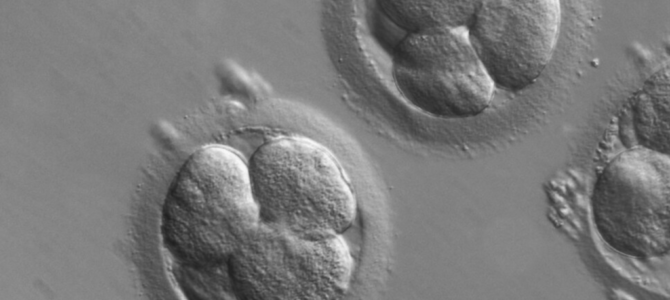
A recent Federalist article posited that embryo adoption has damaged children’s rights. The author conflated embryo adoption with embryo donation, raising several criticisms about the inherent nature of embryo donation. Embryo adoption, however, actually does exactly the opposite: Children who otherwise would not be born have the right to become born into a chosen, loving, permanent adopting family.
In the past when a couple learned they were infertile, their first and likely only option was to turn to adoption through a domestic or international program. In 1978, the first test tube baby was born, ushering in the brave new world of assisted reproductive technologies (ART). In particular, the ART procedure known as in vitro fertilization (IVF) has become the solution for many.
Often a cycle of IVF creates more embryos than the family will ever be able to use for pregnancies. The remaining embryos are cryogenically preserved but languish in frozen storage until a decision is made about what to do with them, or they perish. Well more than 1,000,000 embryos are now in frozen storage in the United States, posing a looming social and moral crisis.
Embryo Adoption Is Bigger than Embryo Donation
In 1997, Nightlight Christian Adoptions established the world’s first embryo adoption program and called it Snowflakes because each embryos is frozen and unique. Its purpose is to empower couples with remaining embryos.
The program accomplishes this by giving these couples the ability to choose the family who would receive their remaining embryos (adopt them, for the baby is not genetically related to the parents) and hopefully give birth to them. This is what we call adoption, not embryo donation, and it is child-centric.
Although couples approach IVF with the desperate hope of having a genetic child, they often end up purchasing human eggs or sperm to create more embryos. Why create more embryos when remaining embryos exist at agencies, clinics, and organizations throughout the United States?
We do not take the position that IVF is always wrong. We believe families using IVF should create a very limited number of embryos and that the embryos a family creates should each have the opportunity to be born. We do not believe it is necessary to create more embryos using purchased donor eggs or sperm when there remain embryos available for families to use.
The more our Snowflakes team works with both embryo-placing and adopting families, and the more we understand IVF, we are increasingly uncomfortable with the procedure as it is currently practiced. Helping our clients sort through their feelings of grief and loss is one of the most important services we provide.
Embryo Adoption Mimics Other Adoption Methods
Human eggs and sperm have become a commodity in the United States. Fertility clinics rarely tell their patients about the availability of embryos through an embryo adoption program or other means because profits lie in providing IVF services. These IVF services compound the problem by not using existing embryos and by making even more embryos that may end up in frozen storage indefinitely.
Are embryo-adopted children going to suffer from being separated from their biological parents? First, we must consider that the biological parents may not be the parents at all because they used donor eggs or sperm to create the embryo. These “biological” parents likely do have children who were born through IVF treatment, as most couples who have remaining embryos also contain children born from that set of embryos living in their family. Donating for reproduction is the only life-giving option for their remaining embryos, given that they will not be using them for additional pregnancies.
Using an adoption model for the placement of remaining embryos into families adds many security measures that anonymous donation of embryos through a fertility clinic does not. Adoption agencies keep permanent records of donor-adopter matches. Adoption agencies educate, encourage, and facilitate communication between the donor and adopting family for the benefit of the children primarily, and for the adults. Adoption agencies vet the recipient family using the adoption home study, a requirement for all other forms of adoption.
Adoption agencies can often place all of one donor’s embryos with one adopting family, while fertility clinics often dole out embryos to multiple patients because they have a limited number of embryos available. Embryo adoption agencies can match donor and adopting families based upon both families’ preferences in a match, not simply because embryos are available. The adoption model is attractive to couples with remaining embryos because it gives them a voice in who receives their gift of embryos.
More than 700 babies have been born into loving, permanent families through the Snowflakes program and hundreds more through other child-centric programs in our country. IVF creates embryos with the purpose of having babies born. Embryo adoption provides a proven successful option to give each embryo an opportunity to be born and become a wonderful, loved member of a family.
We Don’t Live in an Ideal World
Ethicists often fall into the trap of making moral pronouncements in an ideal world. Perhaps in an ideal world, people wouldn’t make spare embryos or make embryos at all. Perhaps in an ideal world, only the genetic parents of those embryos would give birth and raise them.
Programs such as Snowflakes entered a world that is not ideal. Spare embryos already existed. Embryos created by anonymous sperm and egg donors already existed. Anonymous donation of embryos to other couples already existed. It was in the midst of this already non-ideal situation that these programs sought to solve already-existing problems.
The questions we really need to be asking are: Given that remaining embryos exist and the people who are storing those embryos refuse to give birth to them, what should be done with them? Given that remaining embryos created by anonymous egg and sperm donations exist, and therefore cannot be raised by their genetic parents, what should be done with them?









